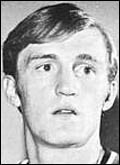Category Archives: Hockey Violence
In an earlier blog post about the potential discrimination against American hockey players in the 1970s, I mentioned how the perception that American players were less prone to fighting might have played a role in the NHL’s reluctance to accept them in larger numbers. The theme of fighting and violence in the 1970s comes up a lot as I look through hockey coverage from that decade.
The violence issue came up in researching Don Saleski, who was criminally charged for an altercation with a security guard in 1976. The issue arose again in researching Greg Polis, who was once sued by a Penguins fan. Hockey was on trial in the court of public opinion for much of the 1970s.
So far the most interesting violence-related news of the 1970s came up in my recent research on Dan Maloney, the former player and coach whose fighting skills were legendary in their day. The folks who visit sites like hockeyfights.com probably can speak more to Maloney’s prowess than me, but it’s clear that some fans who bought tickets in the 1970s must have felt they were getting their money’s worth when Maloney dropped the gloves.
Anyway, Maloney made history during the 1975-76 season when he became the public scapegoat for all violence in the NHL. You can read the whole story on his profile page, but the basics are that he became caught up in a Canadian politician’s efforts to show his constituents that he found violence in hockey abhorrent and that players on the ice should not be exempt from the rules of society. When Maloney was charged with assault on Toronto defenseman Brian Glennie, the case made headlines across North America. Several months later, it took a jury trial to find him not guilty. His lawyers did an outstanding job defending him and probably protected the NHL’s image in the process. They were able to successfully argue that on-ice violence (short of killing an opponent) was part of the culture of professional hockey, and it was unfair to hold someone to societal standards for assault when they had willingly agreed (and were paid) to be part of that culture.
Again, I recommend you click on the Maloney link above to read the whole story of what happened during the 1975-76 season, because it is truly fascinating to see both how violent the game was and how that violence suddenly became a political issue for the attorney general of Ontario. Maloney was the first of at least three players to be criminally charged with assault while playing at Maple Leaf Gardens that season.
One of the interesting things that came up in the Maloney trial was the defense’s assertion that hockey violence only became noteworthy once games started to be televised. The old-time hockey of Gordie Howe’s heyday and earlier was extremely violent, but most of it was never caught on tape, so the society at large didn’t have any concern for it.
I have never been particularly interested in hockey violence, and one of the things I enjoy most about the Olympics is that you don’t see fights. I understand why fighting happens, and I can accept the reasoning behind it. One thing I can say for sure is that the NHL we know today is far less violent than it was in the past. Yes, there is still fighting, but I don’t see the league using it as a selling point, which is clearly what was going on back in the day. The old joke about going to a fight and a seeing a hockey game break out will make little or no sense to a younger generation that is learning to love the game today. But in the 1970s, hockey violence was no joking matter. It was, in fact, what many people were paying to see.

